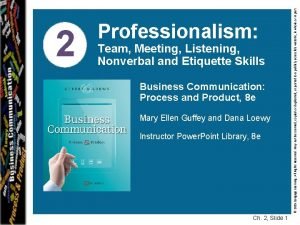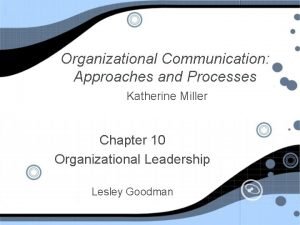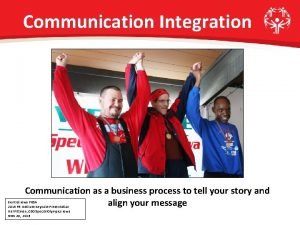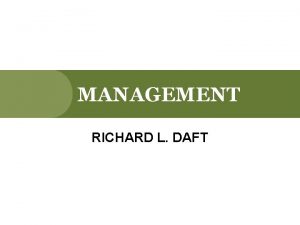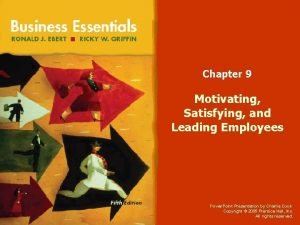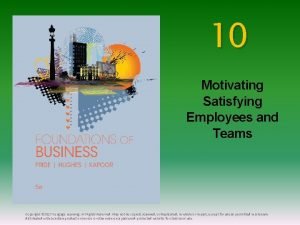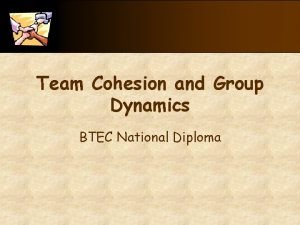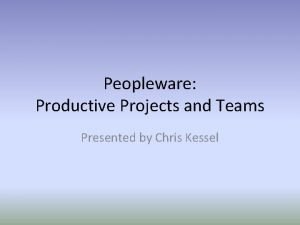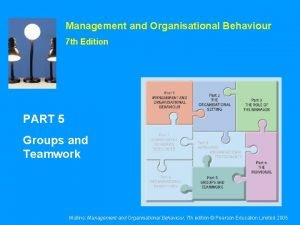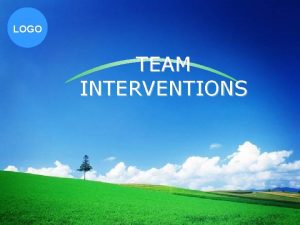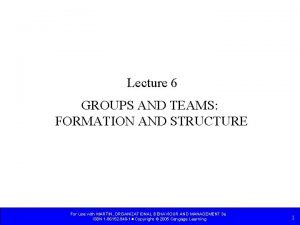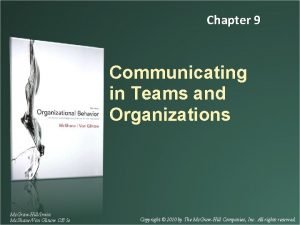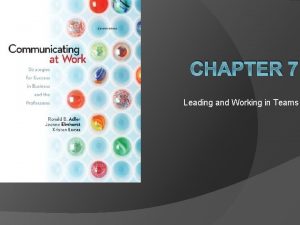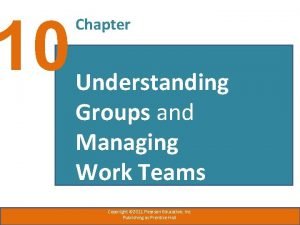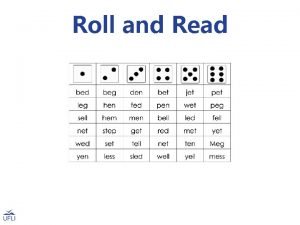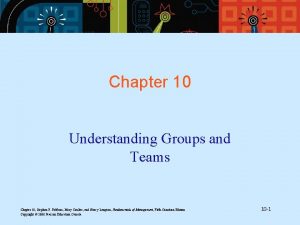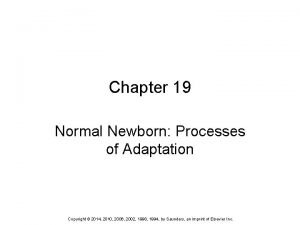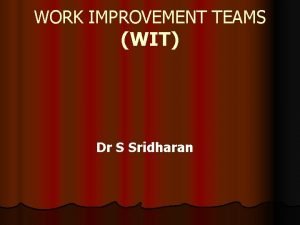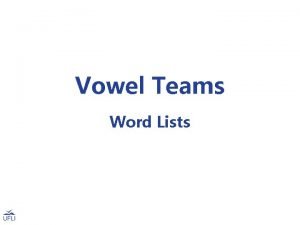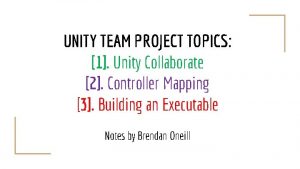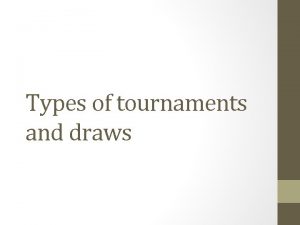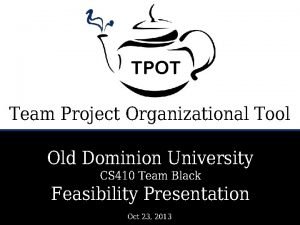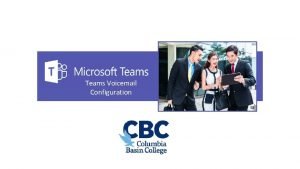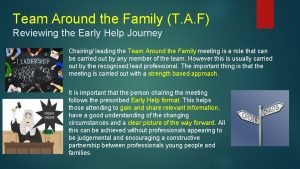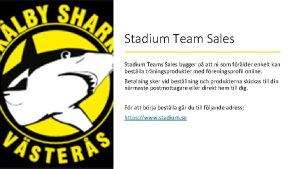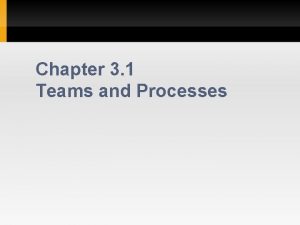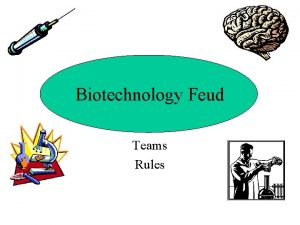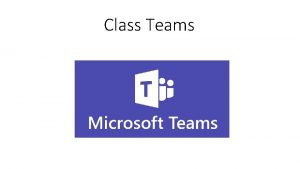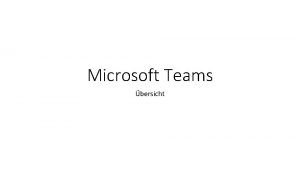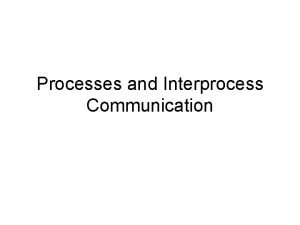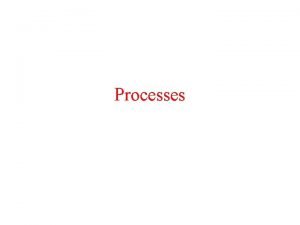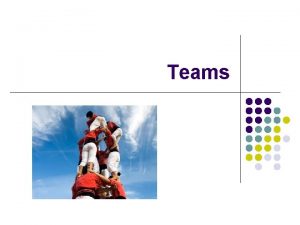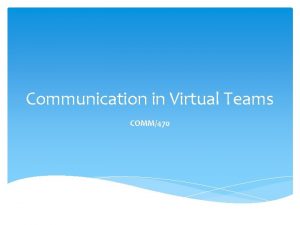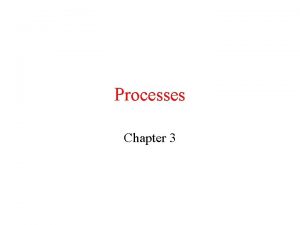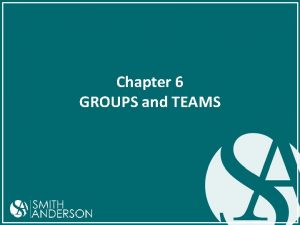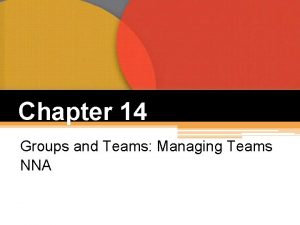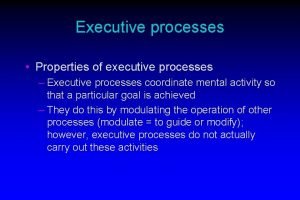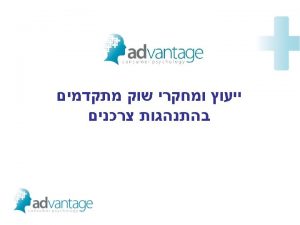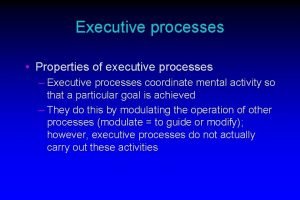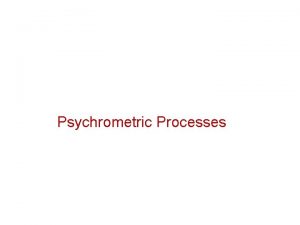Chapter 12 Teams Processes and Communication Slide 12



































- Slides: 35

Chapter 12 Teams: Processes and Communication Slide 12 -1 Copyright © 2011 by The Mc. Graw-Hill Companies, Inc. All rights reserved. Mc. Graw-Hill/Irwin Copyright © 2011 by the Mc. Graw-Hill Companies, Inc. All rights reserved.

Learning Goals § What are taskwork processes, and what are some examples of team activities that fall into this process category? § What are teamwork processes, and what are some examples of team activities that fall into this process category? § What factors influence the communication process in teams? § What are team states, and what are some examples of the states that fall into this process category? § How do team processes affect team performance and team commitment? § What steps can organizations take to improve team processes? Slide 12 -2

Team Processes § Team process is a term that reflects the different types of activities and interactions that occur within teams and contribute to their ultimate end goals. ØTeam characteristics, like member diversity, task interdependence, team size, and so forth, affect team processes. ØTeam processes, in turn, have a strong impact on team effectiveness. Slide 12 -3

Team Value § Process gain is getting more from the team than you would expect according to the capabilities of its individual members. § Process loss is getting less from the team than you would expect based on the capabilities of its individual members. § OB on Screen Ø 300 Slide 12 -4

Process Loss § Coordination loss consumes time and energy that could otherwise be devoted to task activity. Ø Production blocking occurs when members have to wait on one another before they can do their part of the team task. § Motivational loss is the loss in team productivity that occurs when team members do not work as hard as they could. § Social loafing happens when members exert less effort when working on team tasks than they would if they worked alone on those same tasks. Slide 12 -5

Taskwork Processes § Taskwork processes are the activities of team members that relate directly to the accomplishment of team tasks. Ø When teams engage in creative behavior, their activities are focused on generating novel and useful ideas and solutions. v. Brainstorming involves a face-to-face meeting of team members in which each offers as many ideas as possible about some focal problem or issue. v. Nominal group technique is similar to a traditional brainstorming session, but it makes people write down ideas on their own, thereby decreasing social loafing and production blocking. Slide 12 -6

Table 12 -1 IDEO’s Secrets for Brainstorming Slide 12 -7

Taskwork Processes, Cont’d § Decision Making ØDecision informity reflects whether members possess adequate information about their own task responsibilities. ØStaff validity refers to the degree to which members make good recommendations to the leader. ØHierarchical sensitivity reflects the degree to which the leader effectively weighs the recommendations of the members. Slide 12 -8

Taskwork Processes, Cont’d § Boundary Spanning involves activities with individuals and groups other than those who are considered part of the team. Ø Ambassador activities refer to communications that are intended to protect the team, persuade others to support the team, or obtain important resources for the team. Ø Task coordinator activities involve communications that are intended to coordinate task-related issues with people or groups in other functional areas. Ø Scout activities refer to things team members do to obtain information about technology, competitors, or the broader marketplace. Slide 12 -9

Figure 12 -1 Taskwork Processes Slide 12 -10

Discussion Questions § Think of a team you worked in that performed exceptionally well. ØWhat type of taskwork process did the team engage in? ØWhich teamwork processes did the team seem to depend on most to produce the exceptional results? Slide 12 -11

Teamwork Processes § Teamwork processes refer to the interpersonal activities that facilitate the accomplishment of the team’s work but do not directly involve task accomplishment itself. ØBehaviors that create the setting or context in which taskwork can be carried out. ØTransition processes, action processes, interpersonal processes Slide 12 -12

Teamwork Processes, Cont’d § Transition processes are teamwork activities that focus on preparation for future work. Ø Mission analysis involves an analysis of the team’s task, the challenges that face the team, and the resources available for completing the team’s work. Ø Strategy formulation refers to the development of courses of action and contingency plans, and then adapting those plans in light of changes that occur in the team’s environment. Ø Goal specification involves the development and prioritization of goals related to the team’s mission and strategy. Slide 12 -13

Teamwork Processes, Cont’d § Action processes are important as the taskwork is being accomplished. ØMonitoring progress toward goals ØSystems monitoring involves keeping track of things that the team needs to accomplish its work. ØHelping behavior involves members going out of their way to help or back up other team members. ØCoordination refers to synchronizing team members’ activities in a way that makes them mesh effectively and seamlessly. Slide 12 -14

Teamwork Processes, Cont’d § Interpersonal processes are important before, during, or in between periods of taskwork. Ø Motivating and confidence building refers to things team members do or say that affect the degree to which members are motivated to work hard on the task. v. Affect management involves activities that foster a sense of emotional balance and unity. Ø Conflict management involves activities that the team uses to manage conflicts that arise in the course of its work. v Relationship conflict refers to disagreements among team members in terms of interpersonal relationships or incompatibilities with respect to personal values or preferences. v Task conflict refers to disagreements among members about the team’s task. Slide 12 -15

Figure 12 -2 Teamwork Processes Slide 12 -16

Communication § Communication is the process by which information and meaning gets transferred from a sender to a receiver. Figure 12 -3 Slide 12 -17

Communication, Cont’d § Factors that influence the communication process ØCommunication issues v. Participants may lack communication competence, receiver may not be skilled in listening ØNoise ØInformation richness v. Messages transmitted through face-to-face channels have the highest level of information richness ØNetworked structures Slide 12 -18

Communication, Cont’d § Network structure, cont’d ØThe pattern of communication that occurs regularly among each member of the team. v. All channel – highly decentralized v. Circle v. Y v. Wheel – highly centralized ØMembers tend to prefer decentralized network structures Slide 12 -19

Figure 12 -4 Communication Network Structures Slide 12 -20

Team States § Team states refer to specific types of feelings and thoughts that coalesce in the minds of team members as a consequence of their experience working together. ØCohesion, potency, mental models, transactive memory Slide 12 -21

Team States, Cont’d § Cohesion happens when members of teams develop strong emotional bonds to other members of their team and to the team itself. Ø Groupthink happens in highly cohesive teams when members may try to maintain harmony by striving toward consensus on issues without ever offering, seeking, or seriously considering alternative viewpoints and perspectives. § Avoid too much cohesion by assessing the team’s cohesion, and appointing a devil’s advocate. Slide 12 -22

Team States, Cont’d § Potency refers to the degree to which members believe that the team can be effective across a variety of situations and tasks. Ø High potency, members are confident that their team can perform well, and as a consequence, they focus more of their energy on achieving team goals. Ø Team members’ confidence in their own capabilities, their trust in other members’ capabilities, and feedback about past performance play a role in developing high potency. Slide 12 -23

Team States, Cont’d § Mental models refer to the level of common understanding among team members with regard to important aspects of the team and its task. § Transactive memory refers to how specialized knowledge is distributed among members in a manner that results in an effective system of memory for the team. Slide 12 -24

Figure 12 -5 Team States Slide 12 -25

Figure 12 -6 Why Are Some Teams More than the Sum of Their Parts? Slide 12 -26

Importance of Team Processes § Teamwork processes have a moderate positive relationship with team performance. § Teamwork processes have a strong positive relationship with team commitment. Ø Teams that engage in effective teamwork processes tend to continue to exist together into the future. § People tend to be satisfied in teams in which there are effective interpersonal interactions. Slide 12 -27

Figure 12 -7 Effects of Teamwork Process on Performance and Commitment Slide 12 -28

Application: Training Teams § Taken together, knowledge, skills, and abilities are referred to as transportable teamwork competences. ØTrainees can transport what they learn about teamwork from one team context and apply it in another. Slide 12 -29

Table 12 -2 Examples of Knowledge, Skills, and Abilities for Teamwork Slide 12 -30

Training Teams, Cont’d § Cross-training involves training members in the duties and responsibilities of their teammates. Ø Personal clarification happens when members simply receive information regarding the roles of the other team members. Ø Positional modeling involves team members observing how other members perform their roles. Ø Positional rotation gives members actual experience carrying out the responsibilities of their teammates. Slide 12 -31

Training Teams, Cont’d § Team process training occurs in the context of a team experience that facilitates the team being able to function and perform more effectively as an intact unit. Ø Action learning happens when a team is given a real problem that is relevant to the organization and then held accountable for analyzing the problem, developing an action plan, and finally carrying out the action plan. Ø A second type of team process training involves experience in a team context when there are task demands that highlight the importance of effective teamwork processes. Slide 12 -32

Training Teams, Cont’d § Team building training is intended to facilitate the development of team processes related to goal setting, interpersonal relations, problem solving, and role clarification. Ø Ropes course, laser tag, paint ball, scavenger hunts Ø Team building is most likely to have positive effects for smaller teams and when the exercise emphasizes the importance of clarifying role responsibilities. Slide 12 -33

Takeaways § Taskwork processes are the activities of team members that relate directly to the accomplishment of team tasks. Taskwork processes include creative behavior, decision making, and boundary spanning. § Teamwork processes refer to the interpersonal activities that facilitate the accomplishment of the team’s work but do not directly involve task accomplishment itself. Teamwork processes include transition processes, action processes, and interpersonal processes. § Communication is a process through which much of the work in a team is accomplished. Effectiveness in communication can be influenced by the communication competence of the sender and receiver, noise, information richness, and network structure. Slide 12 -34

Takeaways, Cont’d § Team states refer to specific types of feelings and thoughts that coalesce in the minds of team members as a consequence of their experience working together. Team states include cohesion, potency, mental models, and transactive memory. § Teamwork processes have a moderate positive relationship with team performance and a strong positive relationship with team commitment. § Organizations can use training interventions to improve team processes. Such interventions may include training in transportable teamwork competencies, crosstraining, team process training, and team building. Slide 12 -35
 Heel and toe polka step
Heel and toe polka step Concurrent in os
Concurrent in os Teams etiquette slide
Teams etiquette slide Chapter 10 motivating employees
Chapter 10 motivating employees Chapter 10 motivating and satisfying employees and teams
Chapter 10 motivating and satisfying employees and teams Katherine miller organizational communication
Katherine miller organizational communication Communication integration processes
Communication integration processes Factoring problems
Factoring problems Motivating and satisfying employees and teams
Motivating and satisfying employees and teams Motivating and satisfying employees and teams
Motivating and satisfying employees and teams Motivating and satisfying employees and teams
Motivating and satisfying employees and teams How to designing and managing service processes
How to designing and managing service processes Examples of social loafing in sport
Examples of social loafing in sport Peopleware: productive projects and teams
Peopleware: productive projects and teams Difference between team and group
Difference between team and group Groups and teams difference
Groups and teams difference Groups and teams difference
Groups and teams difference Communicating in teams and organizations
Communicating in teams and organizations Leading and working in teams
Leading and working in teams Understanding groups and managing work teams
Understanding groups and managing work teams Words with oi oy sound
Words with oi oy sound Understanding groups and teams
Understanding groups and teams Understanding groups and teams
Understanding groups and teams Chapter 19 normal newborn processes of adaptation
Chapter 19 normal newborn processes of adaptation What is oral communication and written communication
What is oral communication and written communication Definition of oral communication
Definition of oral communication Parallel and serial communication difference
Parallel and serial communication difference Work improvement teams
Work improvement teams Vowel teams word list
Vowel teams word list Unity collaborate
Unity collaborate It is a type of challenge tournament which is similar
It is a type of challenge tournament which is similar Tpot teams
Tpot teams How to set up voicemail on teams
How to set up voicemail on teams Team around family
Team around family Teams stadium
Teams stadium Sphere shield microsoft teams
Sphere shield microsoft teams


